(This article originally appeared in the April 4, 2015 edition of the newsletter)
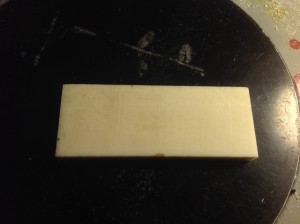
While our dog is a bit upset he wasn’t able to participate in this article, he (and I) really needs more walks and less calories after our incredibly long winter and will get over it.
The easiest place to acquire bone was shared by one of our readers – they go to the big box store for pets and walk down the aisle until they see the nicely cleaned and bleached bones for dogs, picks one up and then goes about cutting, polishing and scrimming it. Smart! Most of the work I’m about to write about is done for you.
The second easiest way is to buy a soup bone from your local grocer or butcher. You can get stew or soup bones in various sizes but for scrimshaw you will want the one that flairs out at one end since this area is not only thicker but also has less voids where capillaries once ran.
After simmering the bone for about an hour and letting it cool, hand it to your four-legged friend to clean the meat out of it and move on to other things. If they haven’t faithfully buried it, the bone should be stripped of most of the meat. Rinse and rewash it, or run it through the dishwasher for a few cycles* .
If you’re going to be gluing this onto or into wood, degreasing the bone is essential. There are two schools of thought when it comes to degreasing: BLTC and natural. BLTC (better living through chemistry) has you soak the bone in white gas or acetone (both flammable, use glass or metal containers and follow safety guidelines and common sense). The natural method is to soak them in a 50/50 mixture of hydrogen peroxide (topical 3%, not the hair bleach type) as noted in “Bonelust: Bad Words: Boil and Bleach“. The third way is to let them sit in the sun and the rain to the oils work out naturally, though this can take several months.
After reading this I wonder if the ox bones I’ve received from Alibaba have been degreased? I’ll be dropping the rest of the lot in a 50/50 mix of H202 just to be sure.
The third way, which we’re finally getting to is to purchase the bone as knife scales. You can get these from Alibaba.com as I have, through Texas Knife Supply,
Amazon, etc.
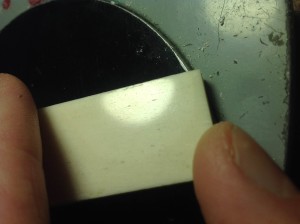
We started with the rough-cut bone, sanding and polishing it to 4000 grit, then coating it with Renaissance Wax and setting it aside for a week. Two days is usually a sufficient rest period for sealing. You can also use beeswax, coating and buffing it into the bone. As you can see here there are micro-fine occlusions where capillaries were. When we polished the bone they became more apparent. I’m curious if stabilized bone has the same qualities.
Marking the bone with various pigments including aquarelle pencil, India Ink and oil paint, I set it to dry for about 30 minutes.
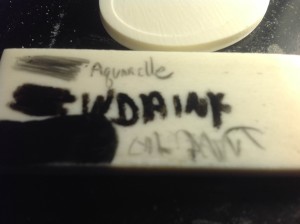
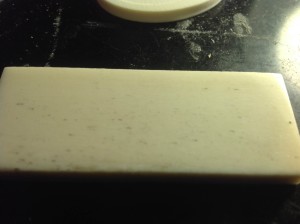
Initially wiping off the bone left some of the India ink, but using a moist towel wiped the rest off easily.
Scrimming:
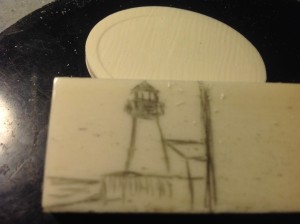
Falling short of my goal to do a lighthouse per day, I have improved with the six I’ve managed to sketch, and the one on the bone I’ll count as my seventh (the whole family got sick one after another, and my dog quickly became jealous of the bucket that was my best friend for a couple of days). The aquarelle pencil marks the bone easily.
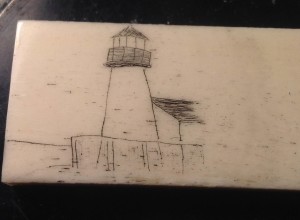
Using the tungsten scrimshaw bit from Coulter Tool the scrimming went easily. Coating the lines with India ink, I took a slurp of coffee and wiped it away, then used a dampened cloth to wipe away the excess. Most of the ink wiped away thanks to my impatience. Next time I’ll ink it, walk the dog so it’s nice and dry, then wipe it away.
After adding more detail I switched over to oil paint to see if it would stand out better but it yielded similar results.
Having started on ivory, any occlusions like those in bone and tagua nut stand out to my eyes, though I’m starting to like the texture of the bone more now, kind of like moving from painting on smooth paper to canvas.
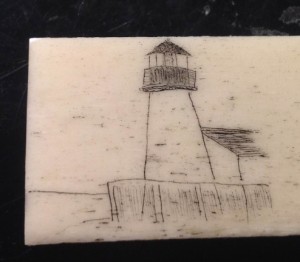
As the bone is too thick at the moment to just cut into cabochons, a cross-cut on the subsequent pieces will need to be performed as well as more sanding and shaping. The material would be excellent for luthiers wanting to make nuts and other parts for their stringed instruments, and would do well for smaller knife handles, also.